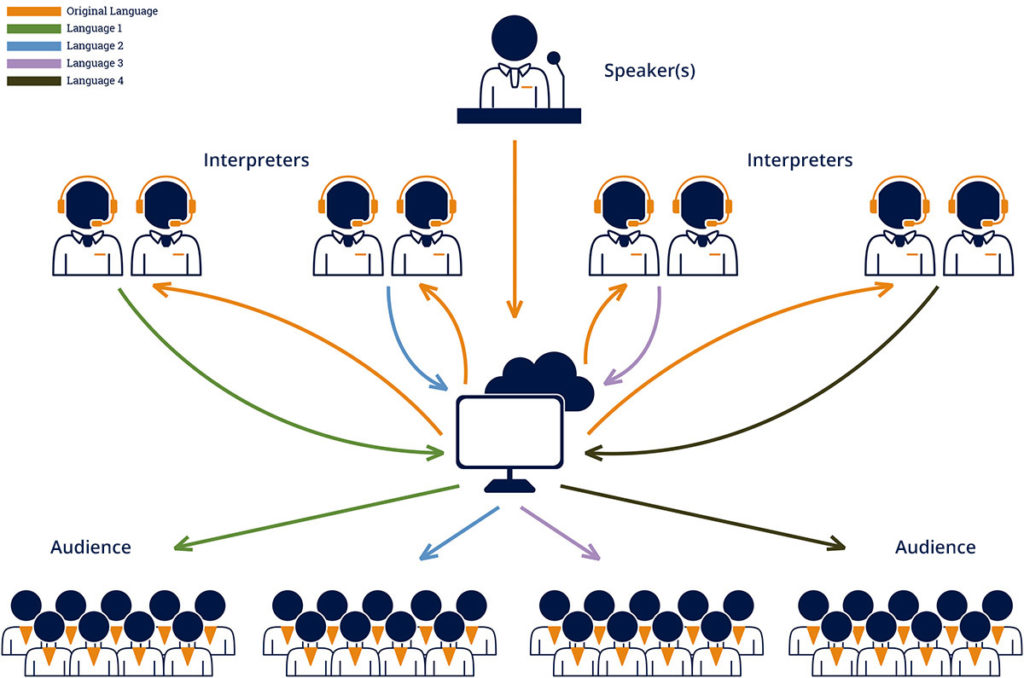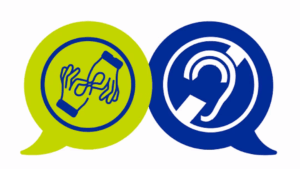There is a fundamental difference between Simultaneous Interpretation Services and Remote Simultaneous Interpretation Services. Simultaneous interpreting is the instantaneous conversion of one spoken language to another; a simultaneous interpreter listens to the words being spoken and immediately renders them in the second language, while simultaneously listening to the next sentence (the first language).
However, when you add the “remote” to the concept of simultaneous interpretation, then you are making it possible for interpreters, speakers and participants to interact from anywhere on the planet. This is so powerful! But there are also challenges.
In this blog, we will give you an overview of the service so you can make an informed decision as to whether RSI would be a good choice for you and your event.
Setup the RSI
Remote Simultaneous Interpreting (RSI) is the delivery of simultaneous language interpretation where the interpreters are located remotely. In the traditional scenario, simultaneous interpretation is provided by an interpreter; who is physically present at the event in order to enable multilingual support for attendees and speaker. The ideal setup allows the interpreter to be in a professional soundproof booth; usually located at the back of the conference room. The delivery of the interpretation is via an audio console connected to the Public Address (PA) system.
It is always recommended that simultaneous interpreters work in pairs and switch every 20 minutes. Simultaneous interpreting assignments are highly demanding and require an intense concentration. Participants are provided wireless receivers that are connected to the channel of their language of choice.
Any simultaneous interpretation assignment requires a significant budget. Transportation, accommodation and per-diems costs; can be considerable even before the hire of interpreters, technicians and high-tech equipment added on. However, in an RSI setup, the interpreters are located offsite (usually in their home booths) and will join the event virtually via an RSI cloud-based platform. Interpreters receive live video & audio feed of the speaker(s) and deliver remote simultaneous interpretation just as if they were working with a classic interpreter console. The participants can listen to the interpretation via the same RSI platform or via a mobile app wherever they are.
Choose your preferred language and use your own device
As during any conventional event, speakers present and attendees can follow the presentation in their preferred language by selecting it on a device. The device can even be the attendees’ own smartphones; if they download the required app. Devices therefore do not need to be shared by different people. In a pandemic environment; the less items we share, the better.
RSI has been around for several years now. But it was often considered a lesser alternative to on site simultaneous interpreting; until the COVID-19 pandemic struck. Now it should seriously be considered as an alternative to a traditional onsite setup. Because many events will be virtual or a hybrid combination of virtual and in-person.
The value of personal interactions and the creation of rapport cannot be achieved exclusively in a virtual set up. Face-to-face interaction and in-person socialization still play an important role. Conferences will come back and people will travel again but RSI will continue to expand a company’s reach; potential attendees for whom language barriers would have otherwise restricted their access to such events; will be able to remotely attend from any location in their own language. Having that experience might help the attendee to assess their in-person attendance next year.
Being able to provide Remote Simultaneous Interpreting becomes part of an event’s value proposition. However, we need to be able to balance all the pros and cons of adding RSI to our event.
The pros and cons of Remote Simultaneous Interpretation
Pros
- Certainly a cost-effective solution (no travel, per diem, equipment and associated onsite fees)
- Speakers, attendees and interpreters are not restricted by location
- Logistical headaches? Scratch that. Multiple breakout rooms, attendees using their own smartphones and headsets; more language combinations otherwise unavailable
- Participants, speakers and interpreters can all join remotely reducing costs and carbon footprint
- Risk mitigation is a positive factor in pandemic situations
- Expanded attendee base
Cons
- Technical glitches. We all know the risks associated with remote setups; (internet connection drop, interpreters’ hardware reliability, platforms’ server downtime…)
- Audio quality could be less reliable compared to an onsite PA system
- Data security, breaches and confidentiality associated with the use of cloud-based systems
- No in-person interaction between interpreters and speakers. This could be a factor to take into consideration; even though it can be overcome.
Event organizers need to carefully evaluate the above pros and cons when considering RSI. A good way to assess if RSI is for you is to consult with a trusted RSI provider
The platforms
Remote simultaneous interpreting uses dedicated software and/or hardware; that allows all participants to join to an event virtually. The platform allows attendees to select from one of audio feeds (languages) offered for the event.
There are many combinations of technological platforms; that will allow you to enjoy a multilingual simultaneous interpretation experience. However, the platform’s usability, reliability and availability is as important as selecting and coordinating the right interpreters; assigning experienced RSI technicians and educating the event managers in RSI best practices. Of course, there are things that could go wrong behind the scenes and an experienced RSI provider will put all necessary contingency plans in place to ensure your RSI’s platform high availability.
RSI in a world post COVID 19
The 2008 crisis has a huge impact on how business was conducted worldwide. Conferences were affected as well: Week-long conferences were reduced to two days travel budgets were slashed and provision for less frequently spoken languages was reduced. At that point in time, virtual conference tools were in their early stages and systems that would have allowed RSI were still expensive.
Ten years on and businesses are facing many similar challenges. However, RSI now allows cost-effective multilingual support for conferences and meetings. RSI has also widened the simultaneous interpreting landscape making it more convenient, offering greater flexibility, and bringing, of course, tremendous cost savings. We can expect large events to resume in the near future. However, RSI is clearly here to stay.
RSI is one response to a new global market landscape. A new backdrop where people seek quick, agile, and cost-effective solutions to suit a variety of situations. Interpreting has still a very strong component linked to human communication. Can we make human communication quick, agile, and cost-effective all the time? Remote Simultaneous Interpretation might well be the answer to your multilingual communication needs.





